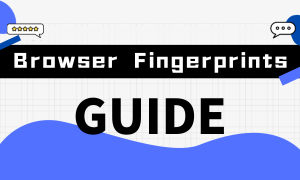Browser Fingerprinting Guide for Beginners
 BrowserScan
BrowserScan
Browserscan aims to simplify the concept of browser fingerprints, enabling you to quickly understand this topic and effectively protect your personal privacy and account security.
Today, we bring you a beginner's guide to browser fingerprinting. In this guide, you can gain a general understanding of browser fingerprint tracking. Here is the table of contents for the article:
What Is Browser Fingerprinting?
Just like your fingerprints, when you visit websites, you also leave behind your own unique personal information.
💡 Browser fingerprinting refers to the tracking technology used by websites to gather information about you.
Websites collect your information through this technology, including details like your operating system, browser version, language preferences, timezone, screen resolution, installed fonts, and more. They then piece together and combine these bits of information to create a unique online fingerprint for you, also known as a browser fingerprints. Each user's browser fingerprint is distinct, and it is extremely unlikely to find someone else with the same browser fingerprint on the Internet.
Due to the distinctiveness of browser fingerprints, websites can accurately identify you even among the vast population of Internet users, numbering in the billions. At present, browser fingerprinting technology can accurately identify users with rates exceeding 90%, and in some instances, reaching as high as 99%.
Browser Fingerprinting Examples
Browser fingerprinting technology is used in different areas, such as:
📌 Digital Marketing
E-commerce, travel, and ticketing websites often run promotions. They use browser fingerprinting to offer different discounts and show prices based on the user's location and browsing habits.
Additionally, advertising companies use browser fingerprinting for personalized ads. If someone likes gaming consoles, they'll see more gaming console ads, while those interested in cosmetics will see cosmetic-related ads.
📌 Customized Content Provision
Browser fingerprints contain information like the user's operating system, browser version, device type, and screen size. Websites use this data to provide a better browsing experience. For example, when you visit a website on a mobile phone, you'll see a different layout and fonts that work well on smaller screens. The content you see on your phone might also be tailored for mobile users, which can be different from what you see on a computer.
📌 Account Security
Originally, browser fingerprinting was primarily used for network security. When an account is accessed from an unfamiliar device or unusual login behavior is detected, websites may ask users to verify their identity or restrict access on new devices.
For instance, financial institutions' security systems can check account fingerprints to check if there are logins from multiple locations or devices in a short period. If suspicious activities are detected, security systems may block certain account actions or proactively lock accounts to ensure their safety.
📌 Account Linking
In order to avoid unfairness and fraudulent activities, websites categorize accounts with similar or identical fingerprints as related, and may even suspend some accounts. Many e-commerce platforms and social media sites have policies against users having multiple accounts, which benefits both the website and its users.
📌 Bot Detection
Websites use browser fingerprinting to distinguish between requests from real users and automated bots. When fingerprint recognition technology detects a request as coming from a web crawler, the website blocks its access. At the same time, the website collects different fingerprints associated with bot traits, such as browser HTTP request headers, request quantities, frequencies, and unusual browsing behavior. This helps the site counteract web crawling and ensures that legitimate users enjoy a smooth browsing experience.
What Data Is Collected?
When users visit websites, their devices send connection requests to display the website's content. The target website can access and collect various information sent by the user's browser, including a wide range of device details. Here are some common fingerprinting information:
IP address
User's time zone
UserAgent string
Installed fonts on the device
Screen resolution
Browser type and version
Browser window size
Browser language settings
Browser extensions
Operating system and version
HTTP request header attributes
Audio and video device information
Canvas rendering data
WebGL rendering data
CPU and GPU information
How Does Browser Fingerprinting Work?
In general, websites utilize JavaScript to run scripts and gather information through the browser's built-in API interfaces. These scripts are designed with legitimate purposes, such as rendering videos or photos. If users prevent their execution, most websites may not function properly or even crash. Fingerprinting scripts, similar to other scripts running on websites, go unnoticed by users.
As a result, when users browse websites using their browsers, they are unaware of the websites collecting their personal information.
There are multiple types of browser fingerprinting techniques, and here are some commonly employed ones:
🌎 IP Address
When users send requests to a website's server, an IP address is needed. The device's IP address is like a house address, and websites can use IP databases to determine the geolocation and position information of the user's IP address, such as the country, state, city, and latitude/longitude.


😄 UserAgent Detection
UserAgent, is a string that includes information about the user's browser, browser version, operating system, and its version. Websites identify different UserAgents to display specific content accordingly.

🎨 Canvas Fingerprinting
Canvas fingerprinting is a technology that the user's browser unknowingly drawing hidden images to obtain a digital fingerprint. During the rendering process, the HTML canvas element displays information about the device, such as background color settings, font size/style, and more. Due to device and hardware differences, the way the image is rendered can vary. Think of it as different masters painting the same flower – while the flower may look the same, the choice of brushes, stroke intensity, and starting direction can differ.
Because of these device-specific variations, Canvas can generate a unique hash value for each device. This hash value can be used to create a completely unique identity for the user's browser on the internet.

🖼️ WebGL Fingerprinting
WebGL fingerprinting is similar to Canvas fingerprinting in that it renders an image and generates a hash value based on different rendering methods, thereby assigning a unique hash value to each device.

📢 Audio Fingerprinting
Audio fingerprinting operates similarly to Canvas and WebGL fingerprinting by leveraging the way a device produces audio to obtain its fingerprint. This technique works only when users give permission to access their microphone or camera.

How to Check Your Browser Fingerprints?
You can use BrowserScan to detect the browser fingerprint information of your device. With BrowserScan, you can view 50+ browser fingerprint attributes, including your IP address, browser version, operating system version, cookie enablement, and other important properties.
Click to check your browser fingerprint.
Final Words
With technological advancements and growing demands, websites are increasingly adopting more advanced techniques for browser fingerprinting. Whether it's to enhance user experiences or prevent fraud, this ongoing process of development is inevitable. In the future, BrowserScan will provide more articles about browser fingerprinting, helping users gain a better understanding of browser fingerprints so can choose suitable methods and tools to protect their privacy.
FAQs
Is cookie tracking the same as browser fingerprinting?
No, in specific regions like the European Union, websites are obligated to inform users and seek their consent for tracking cookies. For example, when you visit certain websites, a notification may appear at the bottom of the page, asking if you accept or decline cookie tracking. In contrast, browser fingerprinting occurs without your knowledge or consent.
The technical implementation and underlying principles of these two methods are distinct. While you can delete cookies, browser fingerprints are not easily removable.
How can I prevent browser fingerprinting?
In reality, completely stopping websites from browser fingerprinting is quite challenging. Browser fingerprinting techniques are widely integrated into webpages as essential elements. For instance, if you were to disable the canvas element, it would disrupt graphic rendering, severely affecting a website's functionality.
Moreover, if you try to block browser fingerprinting, websites might interpret it as an effort to conceal your actual behavior, which could lead to account suspension.
Using a VPN or browsing in incognito mode can provide partial data concealment. However, it's important to understand that browser fingerprinting techniques can gather much more information than expected.
Thus, stopping browser fingerprinting is extremely difficult. The key is to hide real personal data and replace it with authentic information. This method protects your privacy while keeping you looking like a real user, and it doesn't harm your browsing experience.
Read Also
10 Browser Fingerprints to Know in 5 Minutes
Subscribe to my newsletter
Read articles from BrowserScan directly inside your inbox. Subscribe to the newsletter, and don't miss out.
Written by

BrowserScan
BrowserScan
Am I 100% anonymous? Check your browser fingerprints and IP address to find how your online identity looks👉www.browserscan.net